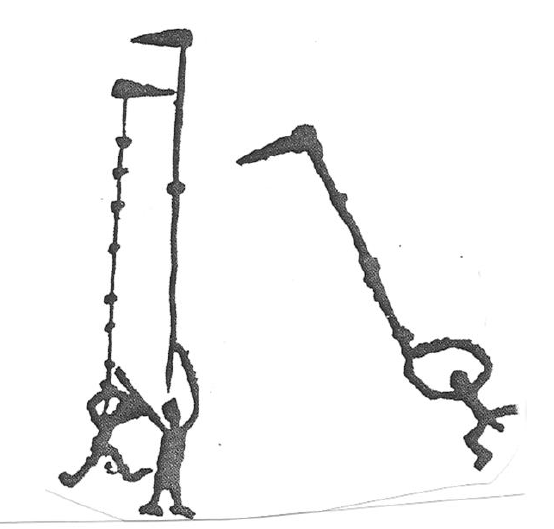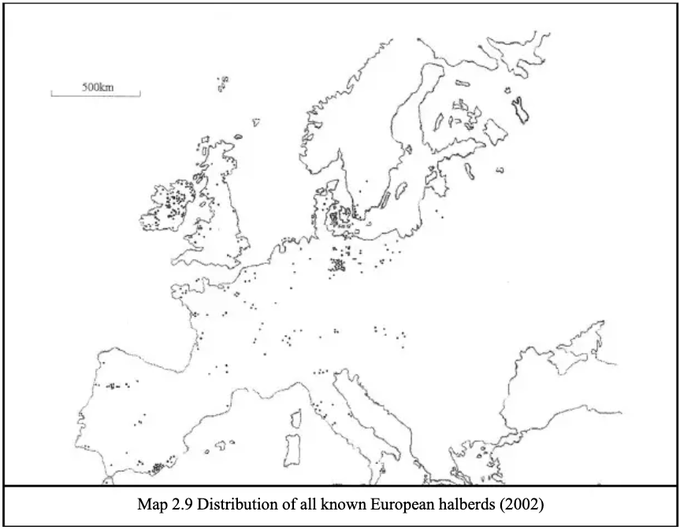One of many Bronze Age halberds found in Ireland...
You know when you were a kid, and you were told that you can't play until you finish your homework?
This must have been how Ronan O'Flaherty felt when he started work on his archaeology PhD in UCD, Ireland...
The title of his thesis was "The Early Bronze Age Halberd in Ireland - Function and Context" and in it he tried to see if he could disprove this:
"Irish halberds have traditionally been regarded as non functional, ceremonial artefacts. In particular, the mode of hafting and the slightness of the haft head have been cited as reasons why this artefact could not have been put to any practical use"...
I know that all he wanted to do was:
1. Cast replicas (Left) of the Bronze Age halberds from the National museum (Right), using the same copper with a very low arsenic level of 0.2%, and without cold-hammering or sharpening of the blades...
2. Haft the halberd replica (Left) based on rock carvings from Mt. Bego, Italy (Right), showing people using (well at least holding high above their heads) the original Bronze Age halberds...
3. Whack some sculls, of the same strength as human sculls, like sheep ones, repeatedly, with the replica halberds, to see what happens...
But before Ronan could do all this fun stuff, he had to do the homework...He collected all the available data about all the so far discovered European Bronze Age halberds...
He then investigated the Early Bronze Age mining and metalworking industry in Ireland and the type of metal and metal artefacts produced during that time, so that he could try to replicate the material and the production of the Bronze Age halberds as closely as possible...
Then he investigated the hafting of Bronze Age halberds...
And finally the use of halberds in battle (from available medieval sources)...
Once he did his homework, Ronan went out to play...
And this is his report:
The replica halberd...revealed itself to be a frighteningly effective weapon, slicing skulls open with disturbing ease and proving very comfortable to handle. A short (couple of feet) chopping blow, was sufficient to pierce the skull, often very deeply indeed...
[The weapon would have been even more efficient] "if it was used by an expert", and "if it wasn't for a certain 21st century distaste of committing such violence in the first place"...Love this 🙂
Repeated blows against twenty sheep skulls, of similar strength to a human skull, failed to inflict all but the most minor damage to the halberd and there was no indication that it could not continue in such use for a prolonged period of time.
The small rounded end of the blade ensured that the full force of the blow is administered to a tiny area of the skull first, virtually guaranteeing a puncture each time.
The fact that the end of the blade was rounded rather than brought to a sharp point added strength to this area, which otherwise might have bent or even snapped on first impact.
This suggests that the blade was designed for impact on bone rather than muscle, where a sharp pointed weapon would seem more appropriate than a blunt-nosed one.
Ronan conclusion: There is no doubt in my mind that the Irish halberd is very carefully designed as a most effective weapon. [Maybe not all] Irish halberds were used in this way, but they certainly could have been and it certainly appears to be the basis for their design.
In addition, the replica halberd survives in a condition which I would categorise as "perfect" in a museum example, suggesting that even these perfect halberds could have seen some use.
Ronan's papers:
"The Early Bronze Age Halberd in Ireland - Function and Context"
"Up close and personal - impact damage on Irish helberds"
To me, most interesting bit of his work is found in boring homework section: the distribution of high concentration halberds sites indicates that they were connected by a well established maritime trading route...
Central European Unetice culture was built around navigable rivers which empty into Baltic sea...From there you can navigate around Scotland to Ireland, Wales and England and along the French coast to Brittany, and then to Iberia, Italy, Greece...
I can bet that all the other inland sites with halberds lie on navigable rivers which empty into the seas along this route...
The existence of maritime trading routes along Mediterranean and Atlantic coast has been attested since Neolithic.
And it was always linked with mining, first for material for stone tools and weapons and then metal for metal tools and weapons...I talked about this in my post "Neolithic seafarers"...
These maritime routes probably facilitated extremely fast spread of Megalithic culture throughout Europe. I talked about this in my post "Childe was right"...
I think this is very very interesting...Particularly when we look at the Irish oral histories, first time recorded in Medieval time, which talk about the existence of such maritime routes along Mediterranean and Atlantic coast during Bronze Age...
I talked about the Irish oral histories and archaeology which seems to support them in the posts linked from this jump page "Montenegrian tumuluses"...
That's it for today...















Could these maritime/riparian halberds been used to open mollusks (like oyster/clam knives) when they weren't bashing skulls? Might they have been derived from stone handaxe cultures that some claim were used to open shellfish?
ReplyDelete